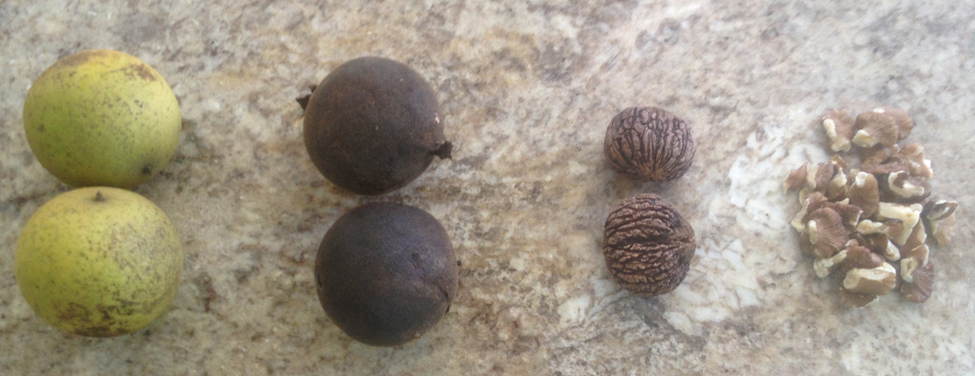Black Walnuts
If you’re driving around the Berkshires and stumble upon what looks like a bucket of tennis balls scattered about, chances are you’ve found a Black Walnut tree (Juglans nigra). The fruits of the Black Walnut tree stay on after the leaves have fallen, and when they start to drop can make quite a racket on roofs or cars, despite the “cushioned” exterior.
The Black Walnut has long been appreciated for its wood as well as its nut. The tree was once so common that its wood was even used for railroad ties and split rail fences, but it was especially favored for gunstocks. The wood is beautiful - plus it was said to have less recoil than any other species, and doesn’t warp, split or shrink. If you plan to carve your own gunstock, these days a Black Walnut gunstock blank runs you about $300 online.
In the mid-1700s, the small arms industry in the Connecticut River Valley used up so many of the local trees that Black Walnut lumber had to be imported from Pennsylvania and Maryland and even from as far as the Ohio Valley west of the Alleghenies. Today’s Black Walnut industry is centered in the Midwestern states, and most of the wood is turned into veneer.
While some love the Black Walnut for the wood, others are fascinated by the earthy, sweet-tasting walnut meat. Native Americans and Early European Settlers used Black Walnuts prolifically. The more familiar and easier-to-crack English (Persian) walnuts weren’t available back then. The Connecticut Agricultural Experiment Station in New Haven notes that the protein level of Black Walnuts is extremely high – 20 times that of milk. New England Abenaki Indians liquefied cooked nutmeats to make a substitute for mother’s milk – one of the first “infant formulas”!
Many of the trees only produce an abundance of nuts every-other-year, so take advantage of the harvest when you see them! How do you enjoy these luscious delights? You “Harvest – Hull – Cure – Crack – Store”.
As the Black Walnuts ripen, the husk changes from bright green to yellow-green. The nuts drop off the trees and the hulls begin to turn black. This black juice stains everything it touches – so be sure to wear rubber gloves when picking the nuts! In Colonial times this juice was used to make ink for quill pens.
We have four Black Walnut trees on our property, so over the years my husband and I have developed a great process for harvesting and storing our own nuts: Put on a strong pair of old boots and remove as much of the outer hull as you can by stomping on the nuts. When you’ve removed as much of this outer flesh as you can, put the nuts in a small cement mixer with some water and pea-stones/pebbles. (This cement mixer/pea stone process was the ingenious idea of our friend, Jim!) Process the nuts with several batches of clean water until the nuts are cleaned and no longer sharp to the touch – this will also make them a lot easier to shell.
After the husks are removed you have to cure the nuts. Spread the cleaned, hulled nuts on newspaper and let them cure in a cool, dry, well-ventilated area for about two weeks. Roll the nuts periodically so they get plenty of air circulation and don’t mold. Choose your spot carefully – if you leave the nuts outside to cure, chances are the resident squirrels will steal your entire harvest!
Whole unshelled Black Walnuts that have been adequately cured will keep almost indefinitely. They also make a gorgeous fall centerpiece! If you’d rather, use a strong nutcracker made especially for cracking the incredibly hard Black Walnuts and store the shelled nutmeats in the freezer for up to two years.
Black Walnuts may be substituted in any recipe that calls for the more common English walnuts, but one of the easiest ways to enjoy their unique flavor is to make Black Walnut Butter. Toast 1 cup of Black Walnut pieces in the microwave, or in a cast iron skillet, for about 1-2 minutes. Place the nuts in a food processor with ½ teaspoon salt and a teaspoon of honey (optional). Process first on low speed, then on high. It only takes a couple of minutes the transform the nut pieces into a delicious nut butter. Store in an airtight container in your refrigerator.
Even the Black Walnut shells have a market! Some folks put the shells in their wood stoves for an alternative heat source. Northern Woodlands Forestry Magazine reported that the ground shells also make a biodegradable, non-toxic, chemically inert abrasive that is used to polish engines or is added to some cosmetics.
The Black Walnut trees seem to have something to offer everyone. Luna moths are particularly fond of snacking on Black Walnut leaves, while grey, red and flying squirrels are all able to easily shell the black walnuts and enjoy the nutmeats.
So – from beautiful furniture to gunstocks to snacks – you really have a gold-mine of delicious opportunity if you’re lucky enough to have access to a Black Walnut tree!
And remember, friends don’t let friends live without BerkshireStyle’s favorite things! Share us.

